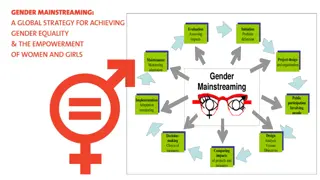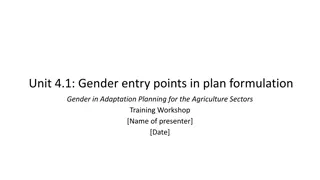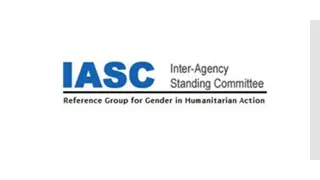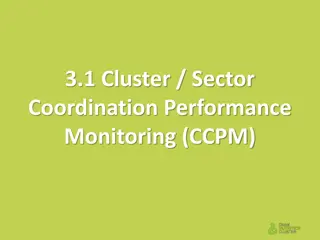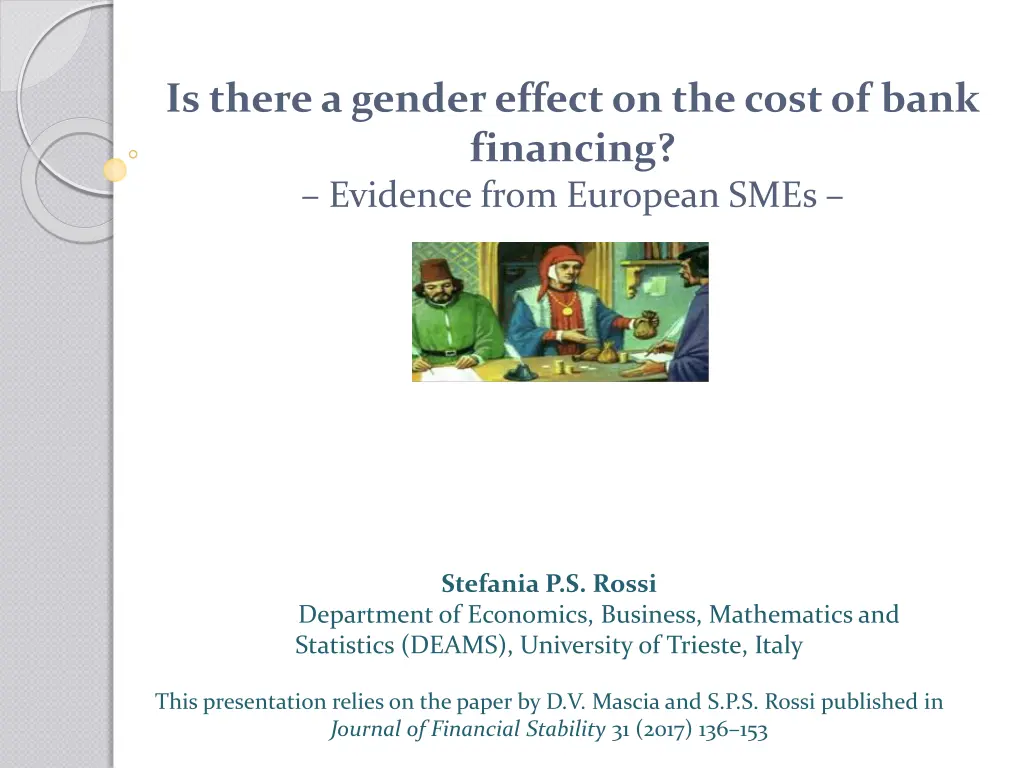
Gender Bias in Bank Financing Costs for European SMEs
Explore the impact of gender on the cost of bank financing for European SMEs. Research indicates that women-led SMEs may face greater difficulties in accessing bank credit due to various demand-driven factors. The study focuses on understanding if there is a gender effect on the access conditions and costs of bank financing for small and medium-sized enterprises, especially in times of financial crisis.
Download Presentation

Please find below an Image/Link to download the presentation.
The content on the website is provided AS IS for your information and personal use only. It may not be sold, licensed, or shared on other websites without obtaining consent from the author. If you encounter any issues during the download, it is possible that the publisher has removed the file from their server.
You are allowed to download the files provided on this website for personal or commercial use, subject to the condition that they are used lawfully. All files are the property of their respective owners.
The content on the website is provided AS IS for your information and personal use only. It may not be sold, licensed, or shared on other websites without obtaining consent from the author.
E N D
Presentation Transcript
Is there a gender effect on the cost of bank financing? Evidence from European SMEs Stefania P.S. Rossi Department of Economics, Business, Mathematics and Statistics (DEAMS), University of Trieste, Italy This presentation relies on the paper by D.V. Mascia and S.P.S. Rossi published in Journal of Financial Stability 31 (2017) 136 153
Motivation Following the global financial crisis, liquidity shortage and heavy restrictions, registered in credit markets, worsened the access conditions to bank credit for non-financial firms in Europe. This phenomenon has specifically affected SMEs because of their specific features. Institute of Economics Uni-Graz, 22.05.2018
Stylized Facts SMEs dominate the business landscape in Europe and are the main drivers of employment, growth and innovation (Behr et al., 2013; De Kok et al., 2011; Ferreira Filipe et al., 2016; Popovand Udell, 2012). SMEs heavily rely on bank credit because they are unable to access equity markets (Ayadi and Gadi, 2013; Kremp and Sevestre, 2013; Vermoesen etal., 2013). Institute of Economics Uni-Graz, 22.05.2018
Stylized Facts SMEs have harder time in obtaining credit than large firms, due to their inability in producing high quality collateral and lack of transparency related to their creditworthiness (Cowan et al., 2015; zt rk and Mrkaic, 2014; Vos etal., 2007). Credit obstacles tend to be more severe in times of crisis thus leading to credit rationing phenomena (Popov and Van-Horen, 2015; Popovand Udell, 2012). Institute of Economics Uni-Graz, 22.05.2018
Research question Are these difficulties in the banking credit access even greater forwomen-led SMEs? Institute of Economics Uni-Graz, 22.05.2018
Literature The literature on gender bias in credit access has focused on: demand-driven factors supply-driven factors Institute of Economics Uni-Graz, 22.05.2018
Literature the demand-driven factors Demand-driven factors are the self-restrain motives of the female borrowerwho decides not toapply for bank loans. women generally tend to be more risk-averse and less self-confident than men; women exhibit a lower propensity toward indebtedness; women are more cautious towards financechoices; (Barber and Odean, 2001; Coleman and Robb, 2009; Croson and Gneezy, 2009; Marlow and Carter, 2006; Treichel-Zimmerman and Scott, 2006) Women s perception of facing more challenges to access bank credit, may itself explain their lower propensity to use external sources (Coleman, 2000; Cole and Mehran, 2011) Institute of Economics Uni-Graz, 22.05.2018
Literature the supply driven factors The supply driven factors focus on the lander s biases against female-led enterprises thatapply forcredit As a consequence of the lender s bias, female entrepreneurs may face: higherrateof loan denial lower credit availability worse cost conditions, than male firms in obtaining bank loans. (Alesina et al., 2013; Aristei and Gallo, 2016; Bellucci et al., 2010; Calcagnini and Lenti, 2008; Colemann, 2000; Carter and Shaw, 2006; Cavalluzzo et al. 2002; Roper and Scott, 2009 ). On the contrary, few papers on US data claim that - after controlling for credit history, assets, sales, and years in business - women who operate small businesses do not face on average higher loan denial rates (Blanchflower et al, 2003; Cavalluzzo and Cavalluzzo 1998; Robb and Wolken, 20009; Madill etal. 2006 (for Canadian firms)). Institute of Economics Uni-Graz, 22.05.2018
Literature the cost of financing A relatively small branch of the literature though most closely related to ours focuseson the effectsof genderon the costof financing for SMEs. Alesina, Lotti, and Mistrulli (2013) have investigated whether the structure of the banking industry, the degree of competition and the presence of small banks, may affect credit access for women. They find that women pay higher interest rates within anystructureof the banking industry. Muravyev, Talavera and Sh fer (2009) find that - for the transition countries - women are morecreditconstrained and pay more. Colemann (2000): Female firms use less external financing, pay more interest rates, are required morecollateral. Institute of Economics Uni-Graz, 22.05.2018
Aim of the paper/our contribution Following this strand of the literature, our contribution would like to shed additional light on the possible existence of gender discrimination related to the cost of bank financing in the credit markets of the 11 euro countries by employing a set of comparable data from non-financial SMEs. While those studies that have investigated the issue of cost disparities in credit access either focusing on a single country or on a cross- country environment employing different datasets, to the best of our knowledge, this is the first attempt to test for such possible disparities in the cost of credit utilizing the ECB Survey on the Access to Finance of Enterprises (SAFE). Institute of Economics Uni-Graz, 22.05.2018
Aim of the paper/our contribution Ourcontribution to the literature is threefold. First, we examine the impact of gender on the change in the cost of bank financing employing the comprehensive survey from the European Central Bank. Second, and more importantly, we develop further this issue by looking at the effects determined by change in gender leadership. Third, causality and endogeneity problems are properly addressed as well. Institute of Economics Uni-Graz, 22.05.2018
Discrimination/1 The literaturedistinguishes two types of discrimination: taste-based or prejudicial discrimination (Becker 1957) which is not motivated by any economic reason but, rather, with the lender preferences and believesabout the gender itself. As a consequence of this prejudicial discrimination, undesired groupwould either i) becharged a higher interestrateon loans, compared to thedesired group; or ii) be required to have better characteristics, such as a lower rate of default at any level of interest rate (Blanchflower et al., 1998). Institute of Economics Uni-Graz, 22.05.2018
Discrimination/2 the statistical discrimination occurs in situations characterized by imperfect information, where the collection of information on the riskiness and creditworthiness is difficultand costly. Thereby in these circumstances it is easier to infer the necessary information by observable demographic characteristics of individuals. Gender can be one of those (Alesinaet al., 2013; Aristei and Gallo, 2016; Moro, 2009). Institute of Economics Uni-Graz, 22.05.2018
Aim of the paper/our contribution More specifically, following the theory of discrimination la Becker (1957) according to which undesired group would be charged higher interest rates on loans compared to the desired group the hypotheses to test in this paperare two. Institute of Economics Uni-Graz, 22.05.2018
Hypotheses We first test whether female-led firms perceive a form of discrimination in the price-terms and conditions of the bank financing. H1: Female-led firms are more likely to experience a worsening in the price terms and conditions of the bank financing than male counterparts. Second, we investigate whether a change in the gender leadership of the firm affects the shift in the cost of bank financing faced by the enterprises in our sample. H2: A change in the leadership i.e., from male to female (from female to male) determines a worsening (an improvement) in the price terms and conditions of the bank financing. Institute of Economics Uni-Graz, 22.05.2018
Hypotheses (cont.) Given the information available in our dataset, we try our best to discern from some types of statistical discrimination by controlling for a series of firm characteristic related to sector of activity, age, size, change in leverage, in profit, in credit history, in collateral, in the available maturity. However, we are aware that any other possible statistical discrimination stemming from the lender side may be out of our control as it might result from the specific information characterizing the bank-firm relationship e.g., any sort of risk factors only observable by the bankers. Institute of Economics Uni-Graz, 22.05.2018
SAFE Dataset The SAFE (Survey on Access to Finance of Enterprises) is a survey of small- and medium- sized enterprises (SMEs) which is jointly run by the European Central Bank (ECB) and the European Commission (EC) every six months since 2009. It collects data on SMEs financial needs, their experience in the access to finance, as well as a series of financial and firm-level characteristics (e.g., size, age, sector, profit, credit demand, creditworthiness, manager s gender). Each wave of the survey is addressed to a randomly selected sample of non-financial firms from the Dun & Bradstreet register. The sample is stratified by country, firm s size and activity. In order to restore the modified proportions, calibrated weights are available to adjust the sample to be representative of the population from which it is extracted. Institute of Economics Uni-Graz, 22.05.2018
Data/sample Our main analysis is based on a sample of 19,969 observations drawn from SAFE related to SMEs chartered in 11 euro-area countries for the period 2009-2013 (i.e., from the 2nd to the 10th wave). The sample is stratified by country, firm s size and activity. Macro data are retrieved from several sources (ECB BLS, ECB Data Warehouse, Eurostat, OECD, World Bank, European Association of Co-operative Banks). Institute of Economics Uni-Graz, 22.05.2018
Observations by size Micro firms are firms with less than 10 employees represent about 26% of the observations in our dataset. Female are 19% of the Micro firms Small firms are firms between 10-49 employees represent about 34% of the observations in our dataset. Female are 11% of the Small firms Medium firms are firms with 50-249 employees represent about 30% of the observations in our dataset. Female firms are 8% of the Medium firms Large firms are firms with more than 250 employees represent about 10% of the observations in our dataset. Female firms are 5% of the Large firms Institute of Economics Uni-Graz, 22.05.2018
Table 1.a Sample distribution Total observations Female observations % (on the full sample) Country Name Frequency Frequency % (at the country level) Austria Belgium Finland France Germany Greece Ireland Italy Netherlands Portugal Spain 1,162 1,078 692 3,620 2,580 1,059 920 3,573 647 997 3,641 5.82 5.40 3.47 18.13 12.92 5.30 4.61 17.89 3.24 4.99 18.23 140 119 73 415 301 92 97 388 39 126 400 12.05 11.04 10.55 11.46 11.67 8.69 10.54 10.86 6.03 12.64 10.99 Sample mean 11.00 Total 19,969 100.00 2,190 Institute of Economics Uni-Graz, 22.05.2018
Description of the dependent variables The vector of dependent variables, called "Terms and conditions of the bank financing", consists of: a) Level of interest rates b) Level of the cost of financing other than interest rates (e.g. fees, commissions) Our dependent variables are qualitative and ordinal and are based on the following question: Code For each of the above mentioned terms and conditions, could you please indicate whether they were increased, remained unchanged or were decreased over the past 6 months? Was decreased by the bank Remained unchanged Was increased by the bank 1 2 3 * The three answer options were recorded as shown above in order to make our dependent variable easier to interpret intuitively. Answers coded with 9 (n.a.) were disregarded. As the labeling is ordinal, any monotonic transformation of it is an equallyvalid labeling. Institute of Economics Uni-Graz, 22.05.2018
Key variables Female, a dummy equal to one if the owner/director/CEO of the firm is female. Change in the leadership is captured by using the first difference of our female dummy, i.e. (Femaleit Femaleit 1). The possible outcomes of this first differentiation are three, namely 1 if a firm changed from a female to a male leadership, 0 if a company did not change its gender leadership, +1 if an enterprise moved from a male to a femaleguidance. On the basis of such outcomes, we generate two dichotomous variables i.e., female-to-male when the first difference is equal to 1, and male-to-female when the first difference is instead equal to +1. Institute of Economics Uni-Graz, 22.05.2018
Empirical model #1 (1) Pr (CBFit) = ? ? ????????+????+ ????+ ????+ ????+ ????+ ???+ ??? CBF indicates the change in the level of the Costof the Bank Financing. Female is our dummy which is equal to 1 when either the owner, director, or CEO of the firm is a female. ???is a vectorof standard firm controls, i.e. size, age, sector; public support to SMEs. ???is a vectorof firm s controlsaccounting for the change in risk, profitability and credit history. ???controls for some non-price conditions of the bank financing, i.e., available maturity of the loan and collateral requirements. ??? is a vector of macroeconomic controls, i.e. GDP growth, rate of inflation, rate of unemployment. ???is a vector of banking market indicators, i.e., non performing loans over gross loans (NPL ratio), change in banks lending activity towards enterprises (Bank Lending Survey BLS), the Herfindahl index (HI) of bank concentration, change in the cost of credit and market share of cooperatives). ??is a vectorof 11 countrydummies. ??controls for the timeeffects across the observed period.
Table 1.b Variable definition and sources Variables Description Source Dependent variables Ordinal variable that equals one/two/three if the level of interest rates experienced by each firm decreased/remained unchanged/increased during the past six months, respectively. Change in the level of interest rates ECB: SAFE Change in the level of the cost of financing Ordinal variable that equals one/two/three if the level of the cost of financing (other than interest rates) experienced by each firm decreased/remained unchanged/increased during the past six months, respectively. ECB: SAFE Gender dummies Female Dummy variable that equals one if the firm s owner/director/CEO is female, and zero otherwise. ECB: SAFE Male-to-Female Dummy variable that equals one if a firm experienced a change in the leadership (from a male to a female owner/director/CEO). ECB: SAFE Female-to-Male Dummy variable that equals one if a firm experienced a change in the leadership (from a female to a male owner/director/CEO). ECB: SAFE Controls for firm quality Leverage up Dummy variable that equals one if a firm experienced an increase in the debt-to-assets ratio in the past six months. ECB: SAFE Leverage down Dummy variable that equals one if a firm experienced a decrease in the debt-to-assets ratio in the past six months. ECB: SAFE Profit up Dummy variable that equals one if a firm experienced an increase of the net income after taxes in the past six months. ECB: SAFE Profit down Dummy variable that equals one if a firm experienced a decrease of the net income after taxes in the past six months. ECB: SAFE Creditworthiness up Dummy variable that equals one if the firm s credit history improved in the past six months. ECB: SAFE Creditworthiness down Dummy variable that equals one if the firm s credit history worsened in the past six months. ECB: SAFE Controls for the non-price conditions of the bank financing Maturity up Dummy variable that equals one if a firm experienced an increase in the available maturity of the loan in the past six months. ECB: SAFE Maturity down Dummy variable that equals one if a firm experienced a decrease in the available maturity of the loan in the past six months. ECB: SAFE Collateral up Dummy variable that equals one if a firm experienced an increase in the collateral requirements in the past six months. ECB: SAFE Collateral down Dummy variable that equals one if a firm experienced a decrease in the collateral requirements in the past six months. ECB: SAFE Additional firm controls Micro Dummy variable that equals one if the firm has between 1 and 9 employees. ECB: SAFE Small Dummy variable that equals one if the firm has between 10 and 49 employees. ECB: SAFE Medium Dummy variable that equals one if the firm has between 50 and 249 employees. ECB: SAFE Very recent Dummy variable that equals one if the firm is less than 2 years old. ECB: SAFE Recent Dummy variable that equals one if the firm is between 2 and 5 years old. ECB: SAFE Old Dummy variable that equals one if the firm is between 5 and 10 years old. ECB: SAFE Construction Dummy variable that equals one if the firm s main activity is construction. ECB: SAFE Manufacturing Dummy variable that equals one if the firm s main activity is manufacturing. ECB: SAFE Wholesale/Retail Dummy variable that equals one if the firm s main activity is wholesale or retail trade. ECB: SAFE Not fully autonomous Dummy variable that equals one if the firm is part of a profit-oriented enterprise, not taking fully autonomous financial decisions. ECB: SAFE Autonomous Dummy variable that equals one if the firm is an autonomous profit-oriented enterprise, making independent financial decisions. ECB: SAFE Public support up Dummy variable that equals one if a firm experienced an improvement in the access to public financial support in the past six months. ECB: SAFE Public support down Dummy variable that equals one if a firm experienced a worsening in the access to public financial support in the past six months. ECB: SAFE Country level controls GDP Growth The annual growth rate of real GDP based on averages of quarterly data for each survey round. OECD Inflation The annual inflation rate based on averages of quarterly data for each survey round. OECD Unemployment The annual unemployment rate based on averages of quarterly data for each survey round. Eurostat Concentration The Herfindahl index (HI) of total assets concentration (for the banking sector). ECB: Data Warehouse BLS The bank credit standards (in the previous three months) based on averages of quarterly data for each survey round. ECB: BLS Cost of borrowing The annual change in the cost of borrowing for loans to non-financial firms. ECB: Data Warehouse European Association of Co- operative Banks Cooperatives The market share of cooperative banks. Institute of Economics Uni-Graz, 22.05.2018 NPL ratio The ratio of bank non-performing loans over total gross loans. World Bank
Empirical model #2 To test H2 we employ the following model: ??(?????) = ?( ?????? ?? ?????? + ??(?????? ?? ????) + ????+ ????+ ????+ ????+ ????+ ???+ ???) (2) Thevariables in this specification areall first-differenced. Notably, when employing this first-differenced model, all firm-fixed effects are effectively washed away in the first-differencing, which makes our estimates very robust indeed the model is conceptually similar to a FE panel model. Institute of Economics Uni-Graz, 22.05.2018
Table 2 Summary statistics Variables Observations Mean St. Dev. p1 p99 Dependent variables Level of interest rates Level of the cost of financing Gender dummies Female Male-to-Female Female-to-Male Controls for firm quality Leverage up Leverage down Profit up Profit down Creditworthiness up Creditworthiness down Controls for the non-price conditions of the bank financing Maturity up Maturity down Collateral up Collateral down 19,969 19,774 2.317 2.485 0.748 0.581 1.000 1.000 3.000 3.000 19,969 5,915 5,915 0.110 0.033 0.034 0.312 0.179 0.182 0.000 0.000 0.000 1.000 1.000 1.000 19,969 19,969 19,969 19,969 19,969 19,969 0.328 0.282 0.240 0.501 0.237 0.214 0.469 0.450 0.427 0.500 0.426 0.410 0.000 0.000 0.000 0.000 0.000 0.000 1.000 1.000 1.000 1.000 1.000 1.000 19,969 19,969 19,969 19,969 0.080 0.095 0.366 0.030 0.271 0.293 0.482 0.170 0.000 0.000 0.000 0.000 1.000 1.000 1.000 1.000 Institute of Economics Uni-Graz, 22.05.2018
Table 2 Summary statistics (cont.) Variables Observations Mean St. Dev. p1 p99 Additional firm controls Micro Small Medium Very recent Recent Old Construction Manufacturing Wholesale/Retail Public support up Public support down Country level controls GDP Growth Inflation Unemployment Concentration BLS Cost of borrowing Cooperatives NPL ratio 19,969 19,969 19,969 19,969 19,969 19,969 19,969 19,969 19,969 19,969 19,969 0.259 0.344 0.302 0.015 0.060 0.119 0.098 0.243 0.296 0.049 0.275 0.438 0.475 0.459 0.120 0.238 0.324 0.297 0.429 0.457 0.215 0.447 0.000 0.000 0.000 0.000 0.000 0.000 0.000 0.000 0.000 0.000 0.000 1.000 1.000 1.000 1.000 1.000 1.000 1.000 1.000 1.000 1.000 1.000 19,969 19,969 19,969 19,969 19,969 19,969 19,969 19,969 -0.212 1.830 12.170 0.076 9.053 -0.100 23.930 7.426 2.553 1.133 6.494 0.064 15.288 0.877 18.501 5.940 -8.200 -0.900 4.700 0.021 -6.000 -2.947 0.000 0.500 5.050 4.900 27.400 0.355 85.000 1.323 60.300 31.899 Institute of Economics Uni-Graz, 22.05.2018
Empirical strategy #1 We estimate an ordered logit model because: our dependent variable is qualitative and strictly ordinal: Firms report the cost of bank loans in the previous six months as having increased , remained unchanged , or deteriorated , labeled respectively by 3, 2, 1. This technique allows the use of continuous variables and multiple categorical variables as regressors. We employ a pooled cross section analysis. All regressions include time and country dummies. Heteroskedasticity-robust standard errors, clustered at the country level, appear in parentheses. Institute of Economics Uni-Graz, 22.05.2018
Empirical strategy #1 - causality As correlation is not causation to handle the issue we adopt two strategies: first we include in model (1) an interaction term of the female dummy with a variable accounting for the firm performance. The idea is to alleviate concerns that the observed variations in the cost of financing are driven by deteriorations in profits (experimented by female-led firms), rather than by the possible discrimination itself. Institute of Economics Uni-Graz, 22.05.2018
Empirical strategy #1 causality and endogeneity Potential endogeneity problem may surround the genderof a firm s leader With no attempt to address endogeneity, one cannot provide evidence of a causal relation Starting with Model 1 we cope with endogeneity utilizing three-step IV regressions la Berger et al. (2016) the share of female employment by sector of activity is used to instrument our female dummy As for Model 2, we face possible endogeneity issues by employing two-step system GMM approach Institute of Economics Uni-Graz, 22.05.2018
Empirical strategy #1 iv method The use of an instrumental variable (IV) method requires the identification of instruments that satisfy the following two criteria, namely the instruments i) must be correlated with the key explanatory variable, and ii) cannot be correlated with the error term. We therefore identify the share of female employment by sector of activity (i.e., construction, manufacturing, mining, wholesale/retail) as a good instrument forour female variable. Such ratio, drawn from Eurostat, is available for each country in our sample and for each survey round (i.e., we computed it as averages of quarterly data). Institute of Economics Uni-Graz, 22.05.2018
Empirical strategy #1 - iv method Because female is dichotomous, we employ a dummy endogenous variable model and apply a three-step approach as proposed in Wooldridge (2002) and implemented by Bergeret al. (2016). This approach implies the use of a probit model for the first step, where we regress our female dummy on the rate of female employment and all the controls from model (1). The fitted value from the first step is then used as an instrument for the second stage. Thus, the second step is a regression of the endogenous variable female on the predicted probability from the first stage and all controls. Finally, the third stage is a regression of the change in the cost of bank financing on the predicted value from the second stage and all the controls as in model (1). Institute of Economics Uni-Graz, 22.05.2018
Empirical strategy #1 - robustness checks We perform some additional robustness checks - controlling for public support -controlling for financial autonomy: excluding subsidiaries and branches Additional analyses - cross-county heterogeneity (three clusters based on Global Gender Gap Index, The World Economic Forum) - macroeconomic shocks Sovereign debt crisis (waves 3, 4, 5; i.e., from 1st April 2010 until 30th September 2011)and announcement of the Outright Monetary Transaction (OMT) Program launched in 2012 (waves 8, 9, 10; i.e., from 1st October 2012 until 31st March 2014). Institute of Economics Uni-Graz, 22.05.2018
Table 3 The impact of gender on the level of interest rates Female Firms Controls GDP Growth Inflation Unemployment Concentration BLS Cost of borrowing Cooperatives NPL ratio Constant 1 Constant 2 Observations Pseudo R-squared Time dummies Country dummies Change in the level of interest rates (2) 0.104** 0.100** (0.05) (0.05) YES YES (0.02) (0.02) -0.044 -0.004 (0.05) (0.04) 0.293*** 0.146** (0.07) (0.07) 0.149*** 0.130*** (0.03) (0.03) -14.953** -12.782* (7.42) (7.38) 0.007 0.000 (0.01) (0.01) 0.708*** (0.20) -0.636 -0.938 (0.77) (0.71) 1.331* 1.029 (0.81) (0.73) 19,969 19,969 0.153 0.154 YES YES YES YES (1) (3) (4) 0.107** (0.05) YES 0.105** (0.05) YES (0.02) 0.017 (0.04) 0.129 (0.09) 0.124*** (0.03) -15.241* (8.75) 0.001 (0.01) 0.727*** (0.25) -0.023*** (0.01) -1.474* (0.85) 0.499 (0.87) 19,969 0.154 YES YES (0.02) 0.016 (0.05) 0.156* (0.09) 0.095** (0.04) -17.146** (8.39) 0.001 (0.01) 0.742*** (0.24) -0.020*** (0.01) 0.043 (0.03) -1.709** (0.84) 0.265 (0.85) 19,969 0.154 YES YES Institute of Economics Uni-Graz, 22.05.2018
Table 4 The impact of gender on the level of the other costs Change in the level of the cost of financing (other than interest rates) (1) (2) 0.170*** 0.168*** (0.05) (0.05) Female (3) (4) 0.169*** (0.05) 0.167*** (0.05) YES -0.048** (0.02) 0.100 (0.07) 0.043*** (0.01) -5.581 (3.89) 0.005 (0.00) 0.413** (0.17) 0.001 (0.00) 0.043*** (0.02) -2.677*** (0.55) 0.906** (0.40) YES YES YES Firms Controls GDP Growth Inflation Unemployment Concentration BLS Cost of borrowing Cooperatives NPL ratio Constant 1 Constant 2 Observations Pseudo R-squared Time dummies Country dummies -0.066** (0.03) 0.159*** (0.05) 0.084*** (0.02) -4.665 (3.42) 0.010*** (0.00) -2.216*** (0.48) 1.367*** (0.42) 19,774 0.155 YES YES -0.047* (0.03) 0.078 (0.07) 0.073*** (0.02) -3.458 (3.80) 0.005* (0.00) 0.399** (0.17) -2.398*** (0.50) 1.185*** (0.40) 19,774 0.156 YES YES -0.046* (0.03) 0.077 (0.07) 0.073*** (0.02) -3.632 (3.96) 0.005* (0.00) 0.400** (0.17) -0.002 (0.00) -2.438*** (0.53) 1.145*** (0.41) 19,774 0.156 YES YES 19,774 0.156 YES YES Institute of Economics Uni-Graz, 22.05.2018
Table 5 Marginal effects Change in the level of the cost of financing other than interest rates dy/dx Y=decreased (3) Change in the level of Interest rates dy/dx dy/dx dy/dx Y=decreased Y=increased Y=increased (1) (2) (4) Female Controls for firm quality Leverage up Leverage down Profit up Profit down Creditworthiness up Creditworthiness down Controls for the non-price conditions of the bank financing Maturity up Maturity down Collateral up Collateral down Additional firm controls Micro Small Medium Very recent Recent Old Construction Manufacturing Wholesale/Retail -0.012 ** 0.026 ** -0.004 *** 0.042 *** -0.016 * 0.005 -0.002 -0.020 *** 0.018 *** -0.037 *** 0.033 * -0.010 0.005 0.042 *** -0.035 *** 0.082 *** -0.004 * 0.003 *** 0.003 * -0.002 0.002 * -0.006 * 0.034 *** -0.025 ** -0.028 ** 0.019 -0.019 *** 0.060 *** 0.010 -0.039 *** -0.076 *** 0.101 *** -0.020 0.090 *** 0.167 *** -0.158 *** -0.004 -0.011 *** -0.024 *** 0.036 *** 0.039 0.115 ** 0.242 *** -0.204 *** 0.002 -0.002 0.004 -0.026 0.014 * 0.001 -0.003 0.009 ** 0.003 -0.003 0.004 -0.009 0.058 -0.027 ** -0.002 0.005 -0.019 ** -0.006 -0.008 -0.006 -0.003 0.013 *** 0.005 0.003 -0.002 -0.001 -0.002 0.079 0.052 * 0.024 * -0.093 *** -0.042 -0.027 0.017 0.013 0.016 Observations 19,969 19,969 19,774 19,774 Institute of Economics Uni-Graz, 22.05.2018
Table 6: Ologit and IV estimates Change in the level of interest rates O. Logit O. Logit (1) (2) 0.105** 0.128* (0.05) (0.07) 0.018 0.027 (0.08) (0.09) -0.098 (0.21) 0.168*** 0.168*** (0.04) (0.04) YES YES YES YES Change in the level of other costs than interest rates O. Logit O. Logit (4) 0.167*** 0.182*** (0.05) (0.03) -0.113** -0.108* (0.06) -0.064 0.075 (0.05) YES YES Female Profit up Female * Profit up Profit down Standard firm controls Macro controls Banking market control Observations Pseudo-R squared Time dummies Country dummies IV (3) IV (6) (5) 3.070*** (0.89) 0.010 (0.03) 0.059** (0.03) YES YES 0.915** (0.43) 0.006 (0.02) 0.052*** (0.01) YES YES (0.06) (0.16) 0.075 (0.05) YES YES YES YES YES YES YES YES 19,969 0.154 YES YES 19,969 0.154 YES YES 18,080 YES YES 19,774 0.156 YES YES 19,774 0.156 YES YES 17,888 YES YES Institute of Economics Uni-Graz, 22.05.2018
Table 7 Robustness: Controlling for public support Change in the level of interest rates Change in the level of other costs than interest rates O. Logit (4) 0.121** (0.06) 0.025 (0.07) 0.200** (0.08) -0.266** (0.11) 0.387*** (0.08) YES YES Female Profit up Female * Profit up Profit down Public support up Public support down Standard firm controls Macro controls Banking market control Observations Pseudo-R squared Time dummies Country dummies O. Logit (1) 0.135** (0.06) -0.007 (0.05) 0.178*** (0.02) -0.208** (0.10) 0.314*** (0.03) YES YES O. Logit (2) 0.156** (0.08) 0.005 (0.07) -0.093 (0.13) 0.178*** 0.058** (0.02) -0.208** (0.10) 0.314*** 0.041 (0.03) YES YES IV (3) 3.091*** (0.89) 0.012 (0.03) O. Logit (5) 0.142*** (0.05) 0.038 (0.07) -0.101 (0.17) 0.200** (0.08) -0.266** (0.11) 0.388*** (0.08) YES YES IV (6) 0.939** (0.43) 0.009 (0.02) 0.049*** (0.01) -0.064** (0.03) 0.071*** (0.02) YES YES (0.03) -0.037 (0.05) (0.03) YES YES YES 18,080 0.160 YES YES YES 18,080 0.160 YES YES YES 18,080 YES YES YES 17,888 0.155 YES YES YES 17,888 0.155 YES YES YES 17,888 YES YES Institute of Economics Uni-Graz, 22.05.2018
Table 8 Robustness: controlling for financial autonomy Change in the level of interest rates Change in the level of other costs than interest rates O. Logit O. Logit (4) 0.111** 0.134** (0.06) 0.042 (0.08) -0.110 0.205** 0.205** (0.09) -0.325** -0.325** (0.14) 0.377*** 0.377*** (0.08) YES YES YES YES Female Profit up Female * Profit up Profit down Public support up Public support down Standard firm controls Macro controls Banking market control Observations Pseudo-R squared Time dummies Country dummies O. Logit (1) 0.138** (0.06) 0.006 (0.05) 0.187*** (0.02) -0.219* (0.12) 0.322*** (0.03) YES YES O. Logit (2) 0.161** (0.08) 0.020 (0.06) -0.107 (0.13) 0.187*** (0.02) -0.219* (0.12) 0.323*** (0.03) YES YES IV (3) IV (6) (5) 3.377*** (1.01) 0.012 (0.04) 0.062* (0.03) 0.006 (0.06) 0.048 (0.03) 0.869** (0.44) 0.010 (0.02) 0.049*** (0.01) -0.069** (0.03) 0.072*** (0.01) (0.06) 0.056 (0.08) (0.18) (0.09) (0.14) (0.08) YES YES YES YES YES YES YES YES 16,528 0.154 YES YES YES YES 16,700 0.164 YES YES 16,700 0.164 YES YES 16,700 YES YES 16,528 0.154 YES YES 16,528 YES YES Institute of Economics Uni-Graz, 22.05.2018
Table 9 Exploring country and time heterogeneity Change in the level of interest rates Country heterogeneity GR, IT, PT AT, BE, DE, Time heterogeneity Sovereign Crisis FI, IE Post-OMT announcement (5) 0.153*** (0.04) 3.6% 1.9% (0.04) -0.076 (0.23) 0.206** (0.09) -0.317*** (0.06) 0.447*** (0.07) -0.251*** (0.09) 7.590 (11.67) -0.015*** (0.00) 0.772*** (0.25) -0.039 (0.10) 0.094 (0.12) 6,607 0.164 YES YES NL (2) Female dy/dx (when Y = increased) dy/dx (when Y = decreased) Public support up Public support down GDP Growth Inflation Unemployment Concentration BLS Cost of borrowing Cooperatives NPL ratio Observations Pseudo-R squared Time dummies Country dummies (1) (3) (4) 0.224** (0.10) 4.9% 1.0% (0.04) -0.018 (0.40) 0.272*** (0.07) 0.034 (0.04) -0.042 (0.12) -0.017 (0.13) 15.051* (9.10) -0.007 (0.01) 0.819 (0.73) -0.215** (0.09) -0.118 (0.12) 5,110 0.101 YES YES 0.196*** (0.06) 3.3% 3.6% (0.07) -0.303*** (0.05) 0.277*** (0.09) 0.022 (0.07) 0.648*** (0.19) 0.154** (0.07) 15.371 (14.71) -0.014*** (0.00) -0.421 (0.79) 0.536*** (0.19) 1.324*** (0.38) 4,937 0.078 YES YES -0.057 (0.44) (0.06) -0.248*** (0.03) 0.439** (0.21) -0.007 (0.02) -0.326** (0.17) 0.313*** (0.03) -33.993*** (3.63) 0.065*** (0.02) -0.393 (0.26) -0.102*** (0.01) 0.126*** (0.02) 1,552 0.079 YES YES 0.193** (0.09) 4.7% 1.3% (0.04) -0.292 (0.19) 0.363*** (0.07) 0.253** (0.11) 0.053 (0.05) 0.093 (0.12) 0.514 (15.12) -0.011 (0.01) 1.365*** (0.46) -0.158 (0.17) -0.073 (0.10) 5,918 0.130 YES YES Institute of Economics Uni-Graz, 22.05.2018
Empirical strategy #2 Panel analysis We exploit the panel natureof ourdataset for testing the second hypothesis (H2) of our study. Indeed, the SAFE dataset has a complex panel structure where the number of firms thatwere repeatedlysurveyed in more than one surveywave is limited. Therefore, we employan ordered logitpanel model with random effects. We use cluster (at the country-level) robust standard errors to control for possible heteroskedasticity and serial dependence across groups in the error structure. Institute of Economics Uni-Graz, 22.05.2018
Empirical strategy #2 Dynamic System GMM estimates Some papers have raised the concern that change in the gender leadership might not be fully exogenous. Because of their features that is, higher attendance at boards, better monitoring abilities, greater aptitude in solving conflicts (see, for instance, Adams and Ferreira, 2009) women may be more likely to be appointed when firms are in critical conditions (see Adams and Ferreira, 2009; Campbell and Vera, 2010). Institute of Economics Uni-Graz, 22.05.2018
Empirical strategy #2 Dynamic System GMM estimates To address such concern we employ a two-step Dynamic System GMM approach (Roodman, 2009), as in Liu et al. (2014), and Pathan and Faff (2013). Indeed, this is a suitable method to overcome potential endogeneity issues arising from reverse i) causality and possible unobserved factors, and to cope with the challenge of identifying proper exogenous ii) instruments for our dummies that capture the change in the gender leadership. Institute of Economics Uni-Graz, 22.05.2018
Empirical strategy #2 Dynamic System GMM estimates Similarly to Pathan and Faff (2013), the model now includes one lag of the dependentvariable as additional regressor. Technically speaking, this approach allows us to treat the key dummies and all the explanatory variables as endogenous while using their past values as instruments. All the explanatory variables are treated as endogenous with the exception of the country-level regressors and time dummies, as in Wintoki et al. (2012) and Pathan and Faff (2013). Institute of Economics Uni-Graz, 22.05.2018
Table 10 Change in leadership Change in the level of the cost of financing (other than interest rates) (3) -0.057 (0.17) -0.050 (0.25) YES Change in the level of interest rates (1) 0.047 (0.14) -0.303** (0.15) YES Male-to-Female Female-to-Male Firms Controls Public support up Public support down GDP Growth Inflation Unemployment Concentration BLS Cost of borrowing Cooperatives NPL ratio Constant 1 Constant 2 Panel-level variance Observations Time dummies Country dummies (2) 0.041 (0.14) -0.304** (0.15) YES (4) -0.043 (0.18) -0.052 (0.24) YES -0.285 (0.18) 0.338*** (0.08) 0.011 (0.05) 0.176 (0.13) 0.300*** (0.10) -6.117 (5.92) 0.005 (0.00) -0.503* (0.30) -0.031** (0.01) 0.011 (0.04) -1.778*** (0.30) 0.568*** (0.21) 0.600*** (0.15) 5,915 YES YES 0.016 (0.30) 0.389*** (0.09) 0.031 (0.06) -0.066 (0.11) 0.337*** (0.09) 3.181 (6.09) 0.004 (0.00) -0.113 (0.12) -0.020 (0.01) -0.048 (0.06) -3.557*** (0.44) 0.293* (0.17) 0.886*** (0.24) 5,878 YES YES 0.015 (0.05) 0.193 (0.13) 0.315*** (0.10) -5.883 (5.71) 0.005 (0.00) -0.523* (0.30) -0.029** (0.01) 0.014 (0.04) -1.783*** (0.29) 0.562*** (0.21) 0.615*** (0.15) 5,915 YES YES 0.035 (0.06) -0.052 (0.10) 0.353*** (0.10) 3.612 (5.85) 0.004 (0.00) -0.134 (0.13) -0.019 (0.01) -0.045 (0.05) -3.598*** (0.43) 0.262* (0.15) 0.926*** (0.24) 5,878 YES YES Institute of Economics Uni-Graz, 22.05.2018
Table 11 Change in leadership Change in the level of the cost of financing (other than interest rates) (3) -0.040 (0.17) YES Change in the level of interest rates (1) 0.020 (0.13) YES Male-to-Female Female-to-Male Firms Controls Public support up Public support down GDP Growth Inflation Unemployment Concentration BLS Cost of borrowing Cooperatives NPL ratio Constant 1 Constant 2 Panel-level variance Observations Time dummies Country dummies (2) (4) -0.301** (0.15) YES -0.049 (0.24) YES -0.284 (0.18) 0.337*** (0.08) 0.012 (0.05) 0.179 (0.13) 0.300*** (0.10) -6.325 (5.80) 0.005 (0.00) -0.505* (0.30) -0.031** (0.01) 0.013 (0.04) -1.753*** (0.30) 0.592*** (0.22) 0.597*** (0.15) 5,915 YES YES -0.284 (0.18) 0.338*** (0.08) 0.011 (0.05) 0.177 (0.13) 0.300*** (0.10) -6.182 (5.89) 0.005 (0.00) -0.503* (0.30) -0.031** (0.01) 0.011 (0.04) -1.776*** (0.29) 0.571*** (0.21) 0.599*** (0.15) 5,915 YES YES 0.016 (0.30) 0.389*** (0.09) 0.031 (0.06) -0.065 (0.11) 0.337*** (0.09) 3.145 (6.13) 0.004 (0.00) -0.114 (0.12) -0.020 (0.01) -0.048 (0.06) -3.553*** (0.43) 0.297* (0.16) 0.886*** (0.24) 5,878 YES YES 0.016 (0.30) 0.389*** (0.09) 0.031 (0.06) -0.065 (0.11) 0.337*** (0.09) 3.128 (6.13) 0.004 (0.00) -0.113 (0.12) -0.020 (0.01) -0.048 (0.06) -3.554*** (0.44) 0.296* (0.17) 0.885*** (0.24) 5,878 YES YES Institute of Economics Uni-Graz, 22.05.2018
Table 12 Change in leadership GMM Male-to-Female Female-to-Male Standard firm controls GDP Growth Inflation Unemployment Concentration BLS Cost of borrowing Cooperatives NPL ratio Observations Time dummies Country dummies AR(1) test p-value AR(2) test p-value Hansen test p-value Change in the level of interest rates (1) 0.027 (0.03) -0.066** (0.03) YES -0.006 (0.01) 0.064*** (0.01) 0.112*** (0.02) -2.617*** (0.98) 0.001 (0.00) -0.242*** (0.04) -0.014*** (0.00) 0.003 (0.01) 3,554 YES YES 0.001 0.990 0.834 (2) 0.040 (0.03) -0.067** (0.03) (3) (4) 0.047* (0.03) -0.074** (0.04) YES -0.010 (0.01) 0.065*** (0.01) 0.104*** (0.02) -2.462** (1.00) 0.000 (0.00) -0.243*** (0.04) -0.015*** (0.00) 0.002 (0.01) 3,554 YES YES 0.001 0.952 0.740 YES YES -0.008 (0.01) 0.065*** (0.01) 0.099*** (0.02) -2.450** (1.01) 0.000 (0.00) -0.247*** (0.04) -0.015*** (0.00) -0.000 (0.01) 3,554 YES YES 0.001 0.997 0.768 -0.010 (0.01) 0.064*** (0.01) 0.102*** (0.02) -2.189** (0.98) 0.000 (0.00) -0.251*** (0.04) -0.015*** (0.00) -0.001 (0.01) 3,554 YES YES 0.001 0.995 0.819 Institute of Economics Uni-Graz, 22.05.2018
Empirical strategy #2 Dynamic System GMM estimates The diagnostic tests provided in Table 12 highlight that the model is properly fitted, with statistically insignificant statistics for both the second-order autocorrelation (i.e., AR(2)) test and the test of over- identifying restrictions (i.e., Hansen). Institute of Economics Uni-Graz, 22.05.2018
Conclusions/1 With all the caveats of the empirical investigation, our approach seems to exclude the presence of statistical discrimination (as we control foran ample seriesof firm characteristics). Rather, our findings seem to support the hypothesis of prejudicial discrimination by the lender that lacks of objective standards when judging female-led applicants. Institute of Economics Uni-Graz, 22.05.2018
Conclusions/2 Our results show that: female-led enterprises face a higher probability of being confronted with a worsening in thecost of the bank financing than male-led ones. female-led firms are 2.6% and 4.2% more likely to experience a worsening in the level of interest rates and in the other costs of the bank financing than their male counterparts, respectively. Results turn to be robust to different model specifications and different econometric strategies. We provide evidence of cross-countries heterogeneity: positive and significant for the first two clusters (i.e., the Southern and the Germanic countries), while no signs of discrimination seem to emerge from the Northern group (i.e., Finland and Ireland). the female dummy is During the period of the Sovereign debt crisis, female-led firms appear to be more discriminated against male firms, compared to the period that followed the OMT announcement. Institute of Economics Uni-Graz, 22.05.2018




